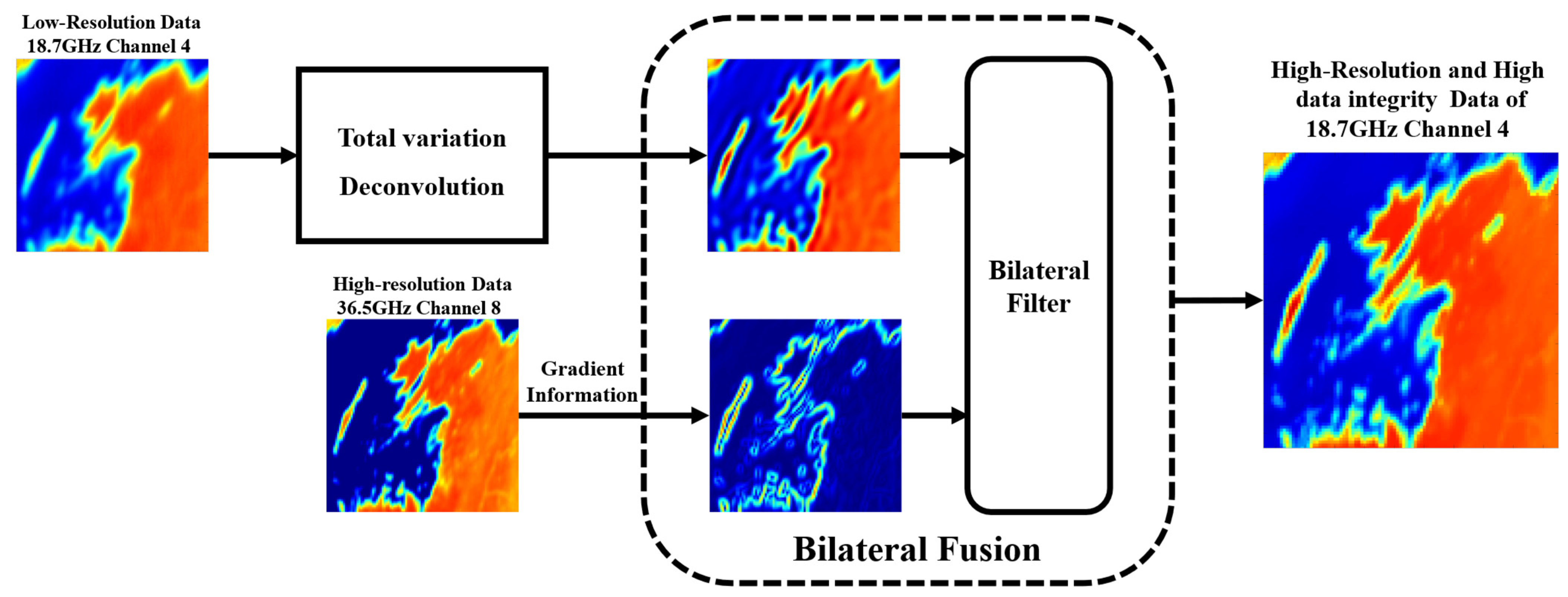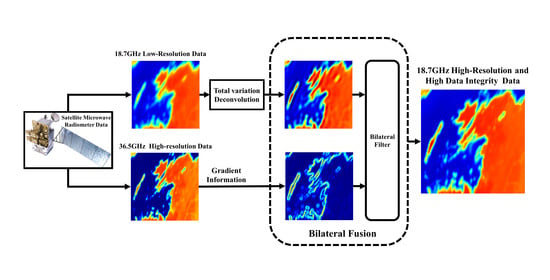Spatial Resolution and Data Integrity Enhancement of Microwave Radiometer Measurements Using Total Variation Deconvolution and Bilateral Fusion Technique
Abstract
:1. Introduction
- A deconvolution algorithm based on TV regularization is proposed to reconstruct the deteriorated image aiming to enhance the spatial resolution with minimal noise amplification.
- A bilateral fusion module is cascaded with the deconvolution module to ameliorate the data integrity of reconstructed data.
- Evaluation methods are proposed to evaluate the resolution enhancement and data integrity in the coastal transition zone.
2. Related Work
2.1. MWRI Instrument
2.2. Imaging Process
2.3. Evaluation Criteria
3. Methods
3.1. Total Variation Regularization Deconvolution
3.2. Data Integrity Enhancement with Bilateral Fusion
3.2.1. Bilateral Filter Denoising
3.2.2. Bilateral Fusion
4. Results
4.1. Synthetic Scenario Evaluation
4.1.1. Synthetic Simulation Data
4.1.2. Synthetic MWRI Data
4.2. Actual MWRI Measurements Evaluation
5. Discussion
6. Conclusions
Author Contributions
Funding
Data Availability Statement
Acknowledgments
Conflicts of Interest
References
- Bindlish, R.; Jackson, T.J.; Wood, E.; Gao, H.; Starks, P.; Bosch, D.; Lakshmi, V. Soil moisture estimates from TRMM Microwave Imager observations over the Southern United States. Remote Sens. Environ. 2003, 85, 507–515. [Google Scholar] [CrossRef]
- Li, X.; Zhao, K.; Wu, L.; Zheng, X.; Jiang, T. Spatiotemporal analysis of snow depth inversion based on the FengYun-3B microwave radiation imager: A case study in Heilongjiang Province, China. J. Appl. Remote Sens. 2014, 8, 084692. [Google Scholar] [CrossRef]
- Wang, Y.; Fu, Y.; Fang, X.; Zhang, Y. Estimating ice water path in tropical cyclones with multispectral microwave data from the FY-3B satellite. IEEE Trans. Geosci. Remote Sens. 2014, 52, 5548–5557. [Google Scholar] [CrossRef]
- Yang, H.; Zou, X.; Li, X.; You, R. Environmental data records from FengYun-3B microwave radiation imager. IEEE Trans. Geosci. Remote Sens. 2012, 50, 4986–4993. [Google Scholar] [CrossRef]
- Sethmann, R.; Burns, B.A.; Heygster, G.C. Spatial resolution improvement of SSM/I data with image restoration techniques. IEEE Trans. Geosci. Remote Sens. 1994, 32, 1144–1151. [Google Scholar] [CrossRef]
- Lenti, F.; Nunziata, F.; Estatico, C.; Migliaccio, M. On the spatial resolution enhancement of microwave radiometer data in Banach spaces. IEEE Trans. Geosci. Remote Sens. 2013, 52, 1834–1842. [Google Scholar] [CrossRef]
- Long, D.G.; Brodzik, M.J.; Hardman, M.A. Enhanced-resolution SMAP brightness temperature image products. IEEE Trans. Geosci. Remote Sens. 2019, 57, 4151–4163. [Google Scholar] [CrossRef]
- Wang, Y.; Shi, J.; Jiang, L.; Du, J.; Tian, B. The development of an algorithm to enhance and match the resolution of satellite measurements from AMSR-E. Sci. China Earth Sci. 2011, 54, 410–419. [Google Scholar] [CrossRef]
- Chen, K.; Fan, X.; Han, W.; Xiao, H. A remapping technique of FY-3D MWRI based on a convolutional neural network for the reduction of representativeness error. IEEE Trans. Geosci. Remote Sens. 2021, 60, 1–11. [Google Scholar] [CrossRef]
- Gentemann, C.L.; Wentz, F.J.; Brewer, M.; Hilburn, K.; Smith, D. Passive microwave remote sensing of the ocean: An overview. In Oceanography from Space; Springer: Dordrecht, The Netherlands, 2010; pp. 13–33. [Google Scholar] [CrossRef]
- Owen, M.P.; Long, D.G. Land-contamination compensation for QuikSCAT near-coastal wind retrieval. IEEE Trans. Geosci. Remote Sens. 2009, 47, 839–850. [Google Scholar] [CrossRef]
- Yang, J.X.; Mckague, D.S.; Ruf, C.S. Land contamination correction for passive microwave radiometer data: Demonstration of wind retrieval in the great lakes using SSM/I. J. Atmos. Ocean. Technol. 2014, 31, 2094–2113. [Google Scholar] [CrossRef] [Green Version]
- Nunziata, F.; Alparone, M.; Camps, A.; Park, H.; Zurita, A.M.; Estatico, C.; Migliaccio, M. An enhanced resolution brightness temperature product for future conical scanning microwave radiometers. IEEE Trans. Geosci. Remote Sens. 2021, 60, 1–12. [Google Scholar] [CrossRef]
- Maeda, T.; Tomii, N.; Seki, M.; Sekiya, K.; Taniguchi, Y.; Shibata, A. Validation of Hi-Resolution Sea Surface Temperature Algorithm Toward the Satellite-Borne Microwave Radiometer AMSR3 Mission. IEEE Geosci. Remote Sens. Lett. 2021, 19, 1–5. [Google Scholar] [CrossRef]
- Choi, M.; Hur, Y. A microwave-optical/infrared disaggregation for improving spatial representation of soil moisture using AMSR-E and MODIS products. Remote Sens. Environ. 2012, 124, 259–269. [Google Scholar] [CrossRef]
- Santi, E. An application of SFIM technique to enhance the spatial resolution of spaceborne microwave imaging radiometers. Int. J. Remote Sens. 2010, 31, 2419–2428. [Google Scholar] [CrossRef]
- Backus, G.E.; Gilbert, J.F. Numerical applications of a formalism for geophysical inverse problems. Geophys. J. Int. 1967, 13, 247–276. [Google Scholar] [CrossRef] [Green Version]
- Stogryn, A. Estimates of brightness temperatures from scanning radiometer data. IEEE Trans. Antennas Propag. 1978, 26, 720–726. [Google Scholar] [CrossRef]
- Long, D.G.; Hardin, P.J.; Whiting, P.T. Resolution enhancement of spaceborne scatterometer data. IEEE Trans. Geosci. Remote Sens. 1993, 31, 700–715. [Google Scholar] [CrossRef] [Green Version]
- Alparone, M.; Nunziata, F.; Estatico, C.; Lenti, F.; Migliaccio, M. An adaptive LP-Penalization method to enhance the spatial resolution of microwave radiometer measurements. IEEE Trans. Geosci. Remote Sens. 2019, 57, 6782–6791. [Google Scholar] [CrossRef]
- Lenti, F.; Nunziata, F.; Estatico, C.; Migliaccio, M. Conjugate gradient method in Hilbert and Banach spaces to enhance the spatial resolution of radiometer data. IEEE Trans. Geosci. Remote Sens. 2015, 54, 397–406. [Google Scholar] [CrossRef]
- Hu, W.; Li, Y.; Zhang, W.; Chen, S.; Lv, X.; Ligthart, L. Spatial resolution enhancement of satellite microwave radiometer data with deep residual convolutional neural network. Remote Sens. 2019, 11, 771. [Google Scholar] [CrossRef] [Green Version]
- Hu, W.; Zhang, W.; Chen, S.; Lv, X.; An, D.; Ligthart, L. A deconvolution technology of microwave radiometer data using convolutional neural networks. Remote Sens. 2018, 10, 275. [Google Scholar] [CrossRef] [Green Version]
- Li, Y.; Hu, W.; Chen, S.; Zhang, W.; Guo, R.; He, J.; Ligthart, L. Spatial resolution matching of microwave radiometer data with convolutional neural network. Remote Sens. 2019, 11, 2432. [Google Scholar] [CrossRef] [Green Version]
- Alparone, M.; Nunziata, F.; Estatico, C.; Migliaccio, M. A multichannel data fusion method to enhance the spatial resolution of microwave radiometer measurements. IEEE Trans. Geosci. Remote Sens. 2020, 59, 2213–2221. [Google Scholar] [CrossRef]
- Alparone, M.; Nunziata, F.; Estatico, C.; Camps, A.; Park, H.; Migliaccio, M. On the trade-off between enhancement of the spatial resolution and noise amplification in conical-scanning microwave radiometers. IEEE Trans. Geosci. Remote Sens. 2022, 60, 1–14. [Google Scholar] [CrossRef]
- Zhou, J.; Yang, H. Noise suppression in ATMS spatial resolution enhancement using adaptive window method. In Proceedings of the 2021 IEEE International Geoscience and Remote Sensing Symposium IGARSS, Brussels, Belgium, 11–16 July 2021; pp. 7693–7695. [Google Scholar]
- Yang, H.; Weng, F.; Lv, L.; Lu, N.; Liu, G.; Bai, M.; Qian, Q.; He, J.; Xu, H. The FengYun-3 microwave radiation imager on-orbit verification. IEEE Trans. Geosci. Remote Sens. 2011, 49, 4552–4560. [Google Scholar] [CrossRef]
- Yang, Z.; Lu, N.; Shi, J.; Zhang, P.; Dong, C.; Yang, J. Overview of FY-3 payload and ground application system. IEEE Trans. Geosci. Remote Sens. 2012, 50, 4846–4853. [Google Scholar] [CrossRef]
- Tang, F.; Zou, X.; Yang, H.; Weng, F. Estimation and correction of geolocation errors in FengYun-3C microwave radiation imager data. IEEE Trans. Geosci. Remote Sens. 2015, 54, 407–420. [Google Scholar] [CrossRef]
- Wang, Z.; Bovik, A.C.; Sheikh, H.R.; Simoncelli, E.P. Image quality assessment: From error visibility to structural similarity. IEEE Trans. Image Process. 2004, 13, 600–612. [Google Scholar] [CrossRef] [Green Version]
- Chan, T.F.; Wong, C.-K. Total variation blind deconvolution. IEEE Trans. Image Process. 1998, 7, 370–375. [Google Scholar] [CrossRef] [Green Version]
- Rockafellar, R.T. Augmented Lagrangians and applications of the proximal point algorithm in convex programming. Math. Oper. Res. 1976, 1, 97–116. [Google Scholar] [CrossRef]
- Chan, S.H.; Khoshabeh, R.; Gibson, K.B.; Gill, P.E.; Nguyen, T.Q. An augmented Lagrangian method for total variation video restoration. IEEE Trans. Image Process. 2011, 20, 3097–3111. [Google Scholar] [CrossRef] [PubMed]
- Gabay, D.; Mercier, B. A dual algorithm for the solution of nonlinear variational problems via finite element approximation. Comput. Math. Appl. 1976, 2, 17–40. [Google Scholar] [CrossRef] [Green Version]
- Li, C. An Efficient Algorithm for Total Variation Regularization with Applications to the Single Pixel Camera and Compressive Sensing; Rice University: Houston, TX, USA, 2010. [Google Scholar]
- Tomasi, C.; Manduchi, R. Bilateral filtering for gray and color images. In Proceedings of the Sixth International Conference on Computer Vision (IEEE Cat. No. 98CH36271), Bombay, India, 4–7 January 1998; pp. 839–846. [Google Scholar]
- Long, D.G.; Daum, D.L. Spatial resolution enhancement of SSM/I data. IEEE Trans. Geosci. Remote Sens. 1998, 36, 407–417. [Google Scholar] [CrossRef] [Green Version]
















| Frequency (GHz) | Polarization | The Instantaneous Field of View (km) | Sampling Interval (km) | Integration Time (ms) |
|---|---|---|---|---|
| 10.65 | V/H | 51 × 85 | 6 × 11 | 15.0 |
| 18.7 | V/H | 30 × 50 | 6 × 11 | 10.0 |
| 23.8 | V/H | 27 × 45 | 6 × 11 | 7.5 |
| 37 | V/H | 18 × 30 | 6 × 11 | 5.0 |
| 89 | V/H | 9 × 15 | 6 × 11 | 2.5 |
| Methods | PSNR (dB) | SSIM | Noise | RF | CP |
|---|---|---|---|---|---|
| 37.0367 | 0.9592 | 1.3262 | 15.1663 | 7 | |
| 38.1755 | 0.9642 | 1.8169 | 26.2721 | 7 | |
| 39.4317 | 0.9726 | 1.2427 | 26.1438 | 7 | |
| 40.9258 | 0.9936 | 0.0881 | 26.7613 | 3 | |
| 41.0187 | 0.9940 | 0.0287 | 27.0301 | 1 |
| Methods | PSNR (dB) | SSIM | RF | CP |
|---|---|---|---|---|
| 30.2345 | 0.8972 | 26.5221 | 7 | |
| 35.6404 | 0.9048 | 43.8413 | 7 | |
| 36.5938 | 0.9361 | 43.7943 | 7 | |
| 37.3895 | 0.9634 | 43.7260 | 5 | |
| 42.5372 | 0.9924 | 45.4776 | 1 |
| Methods | PSNR (dB) | SSIM |
|---|---|---|
| 29.3485 | 0.9045 | |
| 34.4271 | 0.9280 | |
| 35.7685 | 0.9316 | |
| 36.3284 | 0.9612 | |
| 41.3148 | 0.9918 |
| Methods | RF | CP |
|---|---|---|
| 55.7500 | 3 | |
| 38.7800 | 5 | |
| 75.3224 | 7 | |
| 77.3252 | 7 | |
| 77.4811 | 5 | |
| 78.9571 | 4 |
Publisher’s Note: MDPI stays neutral with regard to jurisdictional claims in published maps and institutional affiliations. |
© 2022 by the authors. Licensee MDPI, Basel, Switzerland. This article is an open access article distributed under the terms and conditions of the Creative Commons Attribution (CC BY) license (https://creativecommons.org/licenses/by/4.0/).
Share and Cite
Hu, W.; Yao, Z.; Chen, S.; Xu, Z.; Liu, Y.; Feng, Z.; Ligthart, L. Spatial Resolution and Data Integrity Enhancement of Microwave Radiometer Measurements Using Total Variation Deconvolution and Bilateral Fusion Technique. Remote Sens. 2022, 14, 3502. https://doi.org/10.3390/rs14143502
Hu W, Yao Z, Chen S, Xu Z, Liu Y, Feng Z, Ligthart L. Spatial Resolution and Data Integrity Enhancement of Microwave Radiometer Measurements Using Total Variation Deconvolution and Bilateral Fusion Technique. Remote Sensing. 2022; 14(14):3502. https://doi.org/10.3390/rs14143502
Chicago/Turabian StyleHu, Weidong, Zhiyu Yao, Shi Chen, Zhihao Xu, Yang Liu, Zhiyan Feng, and Leo Ligthart. 2022. "Spatial Resolution and Data Integrity Enhancement of Microwave Radiometer Measurements Using Total Variation Deconvolution and Bilateral Fusion Technique" Remote Sensing 14, no. 14: 3502. https://doi.org/10.3390/rs14143502








